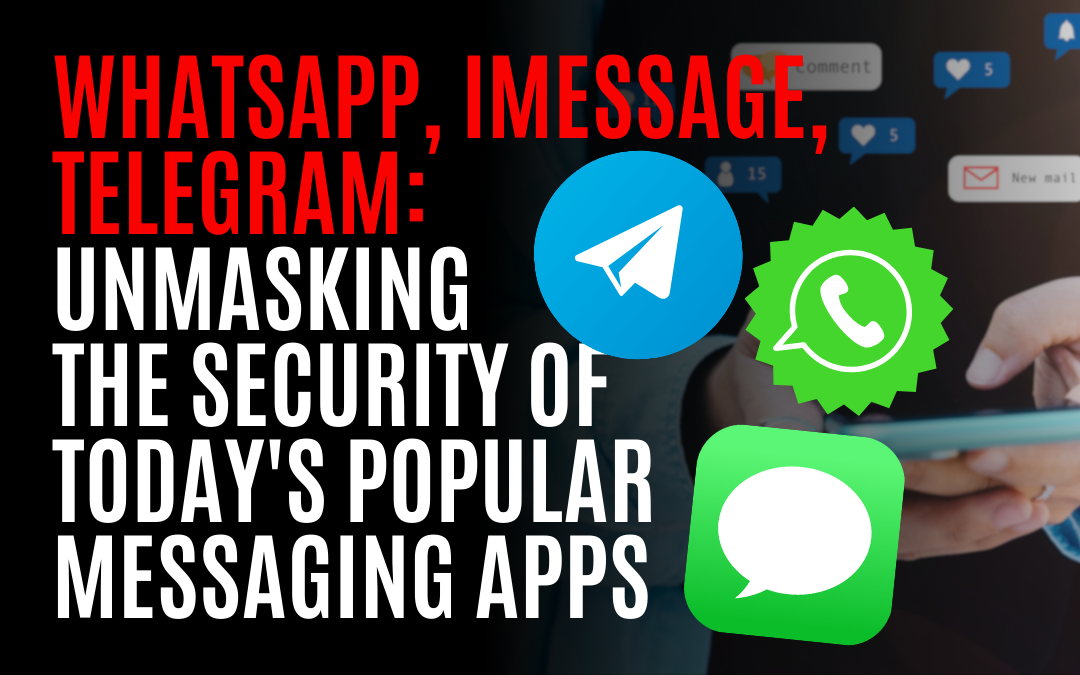https://craigpeterson.com/radio-show/threats-to-our-privacy-tech-industry-told-privacy-is-not-absolute-and-end-to-end-encryption-should-be-rare/17216/Picture this: you’re sitting in your favorite coffee shop, sipping on a perfectly brewed cup of joe ☕, and suddenly, a notification pops up on your phone. It’s a message from a friend with exciting news.
But wait! 🛑 Have you ever stopped to think about how secure your messaging apps really are? In this digital age, where privacy is at the forefront of our minds, it becomes crucial to know which messaging platforms can protect our personal information like a trusty shield ⚔️. Using secure messaging apps is critical in protecting our private conversations from breaches and surveillance. Opting for encrypted communication is a proactive step in safeguarding our digital privacy.
So, What Could Happen?
If you’re using SMS for communication, your messages travel through a network of service providers without the protection of end-to-end encryption. This means they can potentially be intercepted by unauthorized parties with the technical know-how, such as hackers or even rogue telecom employees. Once in their hands, your messages might reveal sensitive information such as passwords, bank account details, personal conversations, or other private data.
With these details, a hoser could commit identity theft, drain your financial accounts, blackmail you by threatening to expose private information, or even track your movements and activities for more nefarious purposes. Essentially, unsecured SMS messages can become a treasure trove for criminals looking to exploit your private life for their gain. That’s why it’s crucial to use secure messaging apps that provide robust encryption, helping to keep your digital correspondence out of the reach of these modern-day digital bandits.
Today, we’re embarking on a journey through the world of secure messaging. Buckle up, and let’s dive in!
Section 1: SMS – An Ancient Hero with Flaws
Here’s the dealio: SMS (Short Message Service) has been around for ages. It’s like that old friend from school who you still keep in touch with but secretly wonder if they’re trustworthy. 😅
SMS was originally designed in the 1980s as part of the GSM (Global System for Mobile communications) standard. Its primary purpose was to send brief, 160-character messages between mobile devices using extra signaling pathways of the cellular network. SMS was intended as a simple, universal way for subscribers to communicate unobtrusively without needing a voice call.
Security was not a primary concern when SMS was conceived; the main focus was on creating a reliable and compatible service that worked across different mobile networks and devices. At the time, there was less awareness of digital security threats, and the infancy of mobile technology meant that the risk of interception and misuse of personal information was not as prevalent or understood as it is today. Therefore, SMS was implemented without robust encryption, allowing the service to operate with minimal complexity and ensuring compatibility with a wide range of devices.
As a result of these design decisions and the context in which SMS was developed, the service does not include modern security features such as end-to-end encryption, making it more vulnerable to eavesdropping and less secure compared to contemporary messaging applications that were developed with encryption from the outset.
👍 Advantages: – Widely available across all devices. – No internet connection is required. – Instant delivery of messages.
👎 Disadvantages: – Vulnerable to interception by hosers. – Limited encryption capabilities. – No end-to-end encryption by default.
Section 2: iMessage – The Apple Sidekick
If you own an iPhone or iPad 🍎📱(lucky duck!), chances are you use iMessage as your go-to messaging app. But does iMessage have what it takes to save the day when it comes to security?
Apple’s iMessage, introduced as part of the iOS 5 release in 2011, was designed to be a more advanced messaging service than traditional SMS, providing users with a range of multimedia capabilities such as sending text, photos, videos, and other data through a data network. It was intended to work seamlessly across all Apple devices, allowing users to communicate effortlessly with each other without relying on the cellular network’s text messaging services.
From the onset, a key feature of iMessage was its focus on privacy and security. Apple implemented end-to-end encryption for iMessage, ensuring that messages could only be read by the sender and the recipient. This encryption was designed to prevent anyone else, including Apple and third parties, from accessing the content of the messages. iMessage also provided various privacy features such as message delivery notifications and optional read receipts, which contributed to its secure and user-friendly design.
iMessage’s encryption has become one of its defining features, reflecting Apple’s broader commitment to user privacy and security that has been emphasized in various aspects of its product ecosystem. The company has consistently maintained that privacy is a fundamental human right and has integrated strong security measures into its software and services to reflect this belief.
👍 Advantages: – Built-in end-to-end encryption for Apple devices only. – Syncs seamlessly between Apple devices.
👎 Disadvantages: – Only accessible if all parties have Apple devices. – Lack of cross-platform compatibility 🚫(Sorry, Android users). – Limited encryption for non-Apple devices.
Section 3: WhatsApp – The Popular Prince(ss)
WhatsApp, the app with over two billion monthly active users, has become a staple for communicating with friends and family across different countries and continents 🌍. But is popularity enough to guarantee security?
WhatsApp was originally designed as an alternative to expensive SMS services. It was founded in 2009 by Brian Acton and Jan Koum, former Yahoo employees, who sought to create a simple, fast, and reliable messaging service that leveraged the internet to send messages, and eventually multimedia, instead of using the cellular SMS infrastructure. The platform quickly grew in popularity due to its ease of use, internet-based messaging capabilities, and avoidance of SMS fees, particularly in countries where texting costs were high.
Initially, the focus on security and privacy in WhatsApp was minimal. The app did not feature end-to-end encryption and had standard security measures that were common for apps at the time. It was mainly designed for convenience and to reduce the cost of texting rather than for securing user communications.
The acquisition of WhatsApp by Facebook in 2014 marked a turning point for the app, especially in terms of privacy concerns. With Facebook’s track record of handling user data, many users expressed worries about how their personal information would be managed. In response to these concerns and the growing demand for secure communications, WhatsApp introduced end-to-end encryption for all forms of communication on the app in 2016, designed by the renowned cryptographer Moxie Marlinspike and his team at Open Whisper Systems. This meant that only the communicating users could read the messages, not even WhatsApp or any other third party.
Nonetheless, WhatsApp has maintained that user privacy and security are of utmost priority, keeping the end-to-end encryption in place despite various challenges and debates over government access to encrypted communications.
👍 Advantages: – End-to-end encryption by default. – Ability to make voice and video calls. – Cross-platform compatibility.
👎 Disadvantages: – Now owned by Facebook, raising privacy concerns. – Encrypted backups aren’t enabled by default. – Requires a phone number for activation 📞.
Section 4: Signal – The Underrated Champion
Move over mainstream apps; Signal is here to claim its throne! Despite being lesser-known, this underdog brings crucial features to the table that secure messaging enthusiasts treasure.
Signal was originally designed for secure, private, and encrypted communication. Developed by Moxie Marlinspike and his team at Open Whisper Systems, Signal launched in 2014 with the explicit goal of providing users with a private means of communication that was free from surveillance and eavesdropping. The app employs state-of-the-art end-to-end encryption to protect all forms of communication between users, including text messages, voice calls, video calls, and multimedia messaging.
From its inception, Signal has placed an extraordinary emphasis on security and privacy. The app is open-source, allowing experts to review its code and ensure its robustness against potential vulnerabilities. Signal does not store metadata and provides minimal information about its users, adhering to the principle that the less data is retained, the better the privacy protection.
Signal’s security protocols, specifically the Signal Protocol, have been widely recognized as the gold standard for encrypted communication and have indeed been adopted by other companies to enhance their own privacy measures. WhatsApp, Facebook Messenger, and Skype are notable examples that have integrated the Signal Protocol into their platforms to offer users end-to-end encrypted messaging options.
Overall, Signal’s focus on privacy and security has made it the preferred choice for users seeking a high level of data protection, and its impact on the industry demonstrates its trusted capabilities in providing secure and private communication standards.
Let’s take a closer look:
👍 Advantages: – End-to-end encryption by default. – Open-source software with independent audits ✅(Translation: it’s trustworthy). – No ads or data mining. Phew!
👎 Disadvantages: – Smaller user base compared to giants like WhatsApp or iMessage. – It lacks some premium features found on other platforms.
Section 5: Telegram – The Hybrid Hero
Telegram appears on the scene as the hybrid hero 🦸♀️, offering both secure messaging and cloud-based storage options. It boasts impressive user numbers but faces scrutiny regarding its level of security.
Telegram was originally designed as a cloud-based messaging app that focused on speed and security. It was launched in 2013 by brothers Nikolai and Pavel Durov, who previously founded the Russian social network VKontakte. Telegram’s goal was to provide a fast and secure way for users to message each other, with the ability to access messages from multiple devices due to its cloud-based nature.
Telegram places a significant emphasis on security and user privacy, though its approach is slightly different from other messaging apps like Signal or WhatsApp. Unlike these apps that offer end-to-end encryption for all communications by default, Telegram uses a standard server-client encryption for regular chat sessions. This means that messages are encrypted on the sender’s device and decrypted on the recipient’s device, but they pass through Telegram’s servers where they could theoretically be accessed.
For enhanced security, Telegram introduced “Secret Chats” which do use end-to-end encryption, ensuring that only the two parties involved in the conversation can read the messages. Additionally, messages in Secret Chats cannot be forwarded and can be set to self-destruct after a specified time.
However, because Telegram’s default chats are not end-to-end encrypted and the company uses its proprietary encryption protocol rather than a widely accepted one, some security experts have criticized Telegram’s model. As a result, while Telegram offers features that appeal to users seeking some level of privacy, it may not satisfy those who require the highest standards of security and privacy for all their messaging interactions. Despite this, Telegram has gained popularity for its combination of speed, security features, and a user-friendly interface.
👍 Advantages: It allows large group chats (up to 200,000 participants!). The Secret Chats feature provides end-to-end encryption.
👎 Disadvantages: – Default chats lack end-to-end encryption. – Questions arise regarding its independence from host governments 🕵️♂️.
Conclusion:
In this digital era, securing our private conversations has never been more critical. We’ve explored the advantages and disadvantages of various messaging platforms, from SMS to Signal.
So what’s the verdict? Well, here’s the dealio: take a moment to reassess your messaging preferences and prioritize your privacy. While each platform has its strengths and weaknesses, it’s crucial to choose a secure messaging app that aligns with your needs. For me, I use Signal where possible. My fallback is Apple iMessage. But when I need to communicate with another group, I often use WhatsApp.
Remember, folks, be cautious when trading secrets or exchanging sensitive information online 💂♀️. Prioritizing security doesn’t mean giving up convenience or cutting ties with friends who use different platforms. It means taking control and protecting yourself in this interconnected world 🌐.
Now, over to you! What do you consider most important when choosing a secure messaging app? Let us know in the comments below! And hey, stay safe out there! 👊


